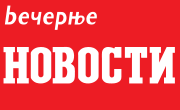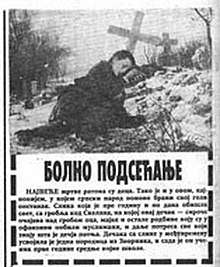Večernje novosti
Večernje novosti (Serbian Cyrillic: Вечерње новости; Evening News) is a Serbian daily tabloid newspaper.[1] Founded in 1953, it quickly grew into a high-circulation daily. Novosti (as most people call it for short) also employs foreign correspondents spread around 23 national capitals around the globe.
 | |
 | |
| Type | Daily newspaper |
|---|---|
| Format | Tabloid |
| Owner(s) | Novosti AD |
| Editor | Milorad Vučelić |
| Founded | 16 October 1953 |
| Political alignment | Serbian Progressive Party |
| Headquarters | Trg Nikole Pašića 7, Belgrade, Serbia |
| Circulation | ~68,000 copies sold (2016) |
| Website | novosti |
The principal Yugoslav-level media companies were Borba and Tanjug. Borba published two daily newspapers, Borba and Večernje novosti. Borba was a daily broad-sheet, was well known as the official voice of the governament, and in the early 1950s, it was the best-selling newspaper in Yugoslavia.[1] The second daily newspaper published by Borba was Večernje novosti, a well-edited evening paper. It was a modern tabloid with short news, human interest stories, big photos, well-written headlines, and many sports, city and regional reports. For a long period of time Veĉernje novosti had the largest circulation in Yugoslavia. Only Večernji list from Zagreb occasionally beat them.[1]
History
It first appeared on stands on 16 October 1953, edited by Slobodan Glumac, who set the newspaper's tone for years to come. Housing an extensive network of journalists and contributors, the paper reported and commented on various issues and events according to its mantra: fast, brief and clear.
In mid-1980s Novosti got a big scoop by publishing the old files of the State Commission for War Crimes, which shed new light on Austrian president Kurt Waldheim's involvement in war crimes during World War II. The file F-25572 dated 17 November 1947, which Novosti published for the first time gave new details of Waldheim's whereabouts in Yugoslavia during the war.
In September 1986, parts of the SANU Memorandum were published by Večernje novosti.[2]

Although it is one of the region's longest enduring newspapers, it is also remembered for its association with the regime of Slobodan Milošević. During the years leading up to the dictator's overthrow, Novosti was one of his main mouthpieces. Loyalty to his regime was the most important job requirement at the paper in this period. Through party-installed apparatchiks like Dušan Cukić (then editor-in-chief), Milošević was able to control the paper and use it to espouse propaganda.
Večernje novosti featured a doctored photo of Milošević's pre-election town meeting in Berane on the cover of its 21 September 2000 edition. The same cluster of trees and people can be spotted on the right and the left of the photomontage. With only a week away from the presidential elections and Milošević trailing behind the opposition, the newspaper made it appear as if over 100,000 supporters came to the meeting. However, independent media reported only 15,000 people were present.[4]
On 4 February 2006, retired basketball ace Vlade Divac expressed his desire to invest in Novosti, perhaps even buy the majority stake, but decided to lie low until the paper's complex ownership structure disputes are resolved.[5][6]
There was also an initial interest from two media conglomerates, WAZ-Mediengruppe and Northcliffe Media, a division of Daily Mail and General Trust in buying a stake in Večernje novosti.[7]
Editorial history
- Slobodan Glumac (1953–1957)[8]
- Vasilije Kraljević (1957–1959)
- Bogdan Pešić (1959–1963)
- Slobodan Glumac (1963–1969)
- Mirko Stamenković (1969–1972)
- Jovan Jauković (1972–1974)
- Živko Milić (1974–1976)
- Tomislav Milinović (1976–1984)
- Ilija Borovnjak (1984–1987)
- Radoslav Brajović (1987–1998)
- Pero Simić (1998–2000)
- Dušan Čukić (2000)
- Manojlo Vukotić (2000–2013)
- Ratko Dmitrović (2013–2017)
- Milorad Vučelić (2017–present)
See also
- List of newspapers in Serbia
- Media in Serbia
References
- Malović, Stjepan; Gary W. Selnow (2001). The People, Press, and Politics of Croatia. Greenwood Publishing Group. pp. 54, 55. ISBN 9780275965433.
- Bokovoy, Melissa (15 January 1997). "State-Society Relations in Yugoslavia, 1945–1992". Palgrave Macmillan – via Google Books.
- "e-novine.com – Pravda za Uroša Predića!". e-novine.com.
- "Media by Milosevic". PBS. Retrieved 13 February 2010.
- "Divac: Neću u novu aferu". Večernje novosti.
- http://www.b92.net/info/vesti/index.php?yyyy=2006&mm=02&dd=04&nav_id=187538
- "London i Esen hoće "Novosti"". Večernje novosti.
- "Svi glavni urednici – Novosti.rs". Večernje novosti.